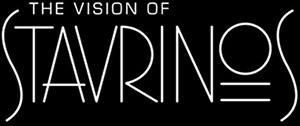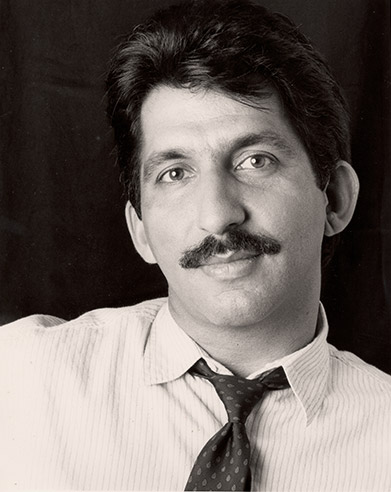
The Life and Art of George Stavrinos
In a career that spanned a mere twenty years, George Stavrinos blazed across the world of editorial and fashion illustration like a comet. As his mature style blossomed in his work for Bergdorf Goodman and other clients, you simply couldn’t ignore him, you couldn’t look away. Over 30 years have passed since his death and it is still impossible to look away. The work is meticulous, it is original and it is undeniably glamorous.
Born in 1948 into a Greek immigrant family in Somerville, Massachusetts, where he was the youngest of seven siblings, George Stavrinos was loved and nutured by his five older sisters. Quiet and withdrawn in his earliest years, he would spread out with his pencils and paper on the floors of the big house on Greenville Street, and draw. George was popular in high school and contributed his paintings and drawings to church and school productions and publications.
Moving on to the Rhode Island School of Design, he majored in graphic design and earned the respect and esteem of his classmates. A senior year spent in Rome helped him to further refine his personal aesthetic, and the elements of fashion and architecture he recorded there found their way into his work for the remainder of his life. With early stops in Boston and Philadelphia, where he found enough assignments to put together a portfolio of samples, George arrived in New York in the early seventies, and the rest is history.
From his early editorial work for newspapers, magazines, books, and record jackets, grew his skill and reputation as a leading illustrator of fashion. He eschewed the then-current trends in order to reintroduce a sense of style, elegance, and film noir into his realistically-rendered large-scale, black-and-white graphite drawings, the work for which he is best known. Each illustration was a slice of frozen cinema, laden with mystery and atmosphere, which left viewers intrigued by the untold backstory that surely existed.
Through the late seventies and early eighties, his appearances in the Sunday Times became eagerly anticipated reveals. He enjoyed mentoring students, whether at the School of Visual Arts or during his 1983 tour of Japan. Through it all, he enjoyed the continuing love and support of his family. His death in 1990 at the age of 42 denied his family, friends and admirers of both his vibrant presence and his fabulous art. His posthumous induction into the Society of Illustrators Hall of Fame in 2007 seemed nothing less than the natural capstone to a short but brilliant career.
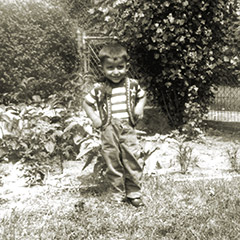
Somerville
George was born and raised in Somerville, a city near Boston, Massachusetts. He was far younger than his oldest brother and his five older sisters who remember him as a quiet child, who loved drawing more than outside play. As a middle school student, George provided murals for plays put on at the local Greek Orthodox church, and in high school he threw himself into the role of artistic director for many of the school’s stage productions. In his senior year, he won a scholarship from the Tiffany Foundation in New York, and upon graduation he headed to the prestigious Rhode Island School of Design to continue his art studies.
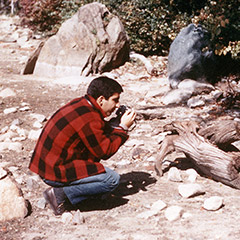
Providence
At the Rhode Island School of Design, George met several fellow students who would remain lifelong friends, including Marcus Reichert, Sally McLeod, Paula Wittner, Ed Rozzo and Bonita Flanders. His initial studies focused on photography, and he took classes with eminent photographers such as Sy Sillman, Harry Benson and Harry Callahan. George became more and more interested in illustration and graphic design
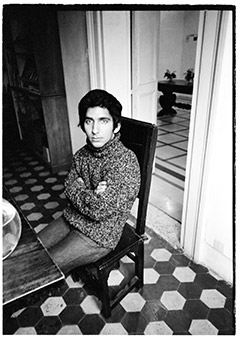
Rome
At the end of his junior year at RISD, George traveled to Rome as part of the European Honors program and spent the summer and fall with about two dozen other RISD students. It was to be a period that would allow him to spread his wings, both personally and artistically. He spent his time learning Italian and taking countless photographs in and around the city, and many of these architectural elements found their way into his illustration over the following decades. Of importance was a side trip that George made to Heraklion in Crete to not only connect with his Greek heritage but to gather more artistic influences for his future work.
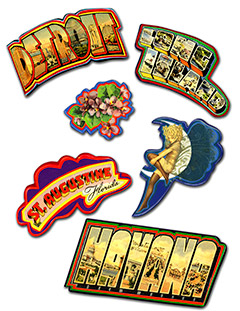
Boston
After graduating from RISD in 1970, George fell ill with mono-like symptoms for several months. It was at this time that he created a series of wearable wooden pins with pictures mounted on them, and which he sold as costume jewelry. After making a full recovery, George moved into a spacious Back Bay apartment in Boston and quickly found work as a freelancer for WGBH-TV, the local PBS station, providing them with photography and illustration work. He also began providing graphics and poster work to local entrepreneur Don Levy and his wife Daryl, who ran an eclectic vintage clothing store called Dazzle. His biggest project was a billboard for the store.
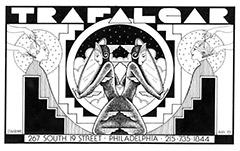
Philadelphia
On the advice of friends and with the promise of work as a muralist, George set out for Philadelphia in 1972. He began producing graphics and murals for restaurants, stores, and other small businesses, often living on site while he worked, and trading artwork for room and board. Victor DiMezzo, who owned and operated the hair salon Trafalgar, was more than pleased to supply George with regular commissions. George created a stream of business cards, display ads, and posters for Trafalgar. “We gave out hundreds of his posters,” recalls DiMezzo. Eventually, George became aware of the limitations of working in Philadelphia and cast his eye toward The Big Apple.
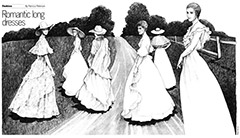
New York
George arrived in New York City in November of 1973, with little more than a month’s expense money in his pocket. But he quickly found work with The New York Times, in its Book Review, Travel and Sunday Magazine sections. In March of 1974, George’s very first fashion-themed spread appeared in the New York Times Magazine. These figures were reminiscent of the family photo-based drawings George had been working on earlier. Rosemary Torre, an instructor of illustration at the Fashion Institute of Technology in New York City, remembers coming across this drawing in the newspaper: “It was these strange little figures, these women in white dresses. And they were rather squat for fashion illustration. He didn’t elongate the figure then. They almost had an Americana look. But very well drawn. And really very pleasant. Very lovely.”
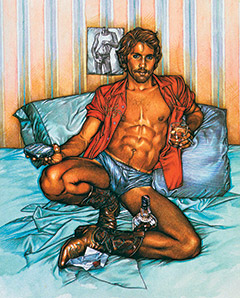
Growing Success
During his early years in New York, George garnered many editorial assignments, including work for New York Magazine and Psychology Today, and album cover design for Columbia Records. He also contributed to groundbreaking magazines such as Blue Boy, Viva and Oui. Mel Odom, a close friend of George’s describes the freedom offered by publications such as these. They wouldn’t get in your way. You could do anything as long as it was gorgeous. And even if it didn’t exactly apply, they’d make it fit.”
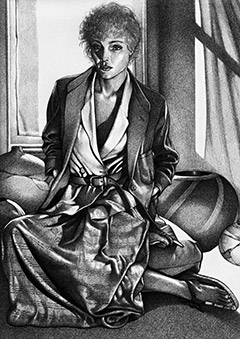
Fashion
Today, George is best known for the gorgeous black and white graphite fashion drawings he began creating in 1976. These drawings, created for Barney’s and Bergdorf Goodman, fashion retailers in NYC, and published as full-page illustrations in the New York Times, provided George with top exposure and a swiftly growing following among lovers of both fashion and illustration. He also appeared in high profile publications such as Cosmopolitan and contributed cover illustrations to a wide range of books.
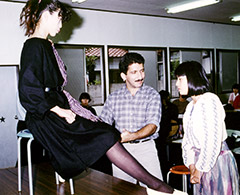
Teaching
George loved to engage with students and offer guidance, and he gave workshops at the Fashion Institute of Technology, and the Art Center College of Design in Pasadena, CA. In 1983 George was invited to travel to Tokyo and gave a series of lectures at Gakuin Designers College branch colleges, including Nagoya, Osaka, and Fukuoka. In summing up George’s visit, Kennosuke Adachi, President of Gakuin College said, “These meetings and seminars have made a great impression on our students and have encouraged them in their studies.”
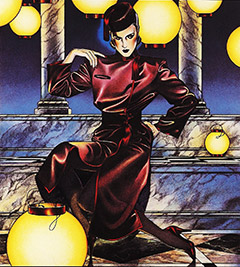
The Finer Things
Eventually, George’s commercial work caught the eye of the fine art world. He’d had a small exhibition of his drawings in 1981 at Tatistcheff Gallery, but in the mid-1980’s his work caught the eye of Steve Diamante, the young director of Ettinger Galleries in NYC. The result was several series of high-quality black and white and full color lithographs that were marketed to fine art collectors. These prints remain highly valued and are sought by collectors.
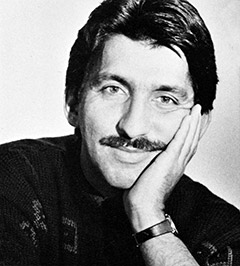
Late in the Day
In June of 1989, George embarked on a trip to Europe, which included a visit to Italy and then to England to spend time with his dear friends Marcus Reichert and Sally MacLeod. It was clear to Sally that he wasn’t well, but he didn’t want to talk about it. “He was his usual discreet self,” recalls Sally. “His trip to us in Northumberland was obviously a good-bye trip. When we parted at the airport, we all knew it might be for the last time.” On the weekend of July 4th, 1990, George was admitted to Beth Israel Hospital in NYC, and on August 3, 1990 George passed away from symptoms related to AIDS, while being transferred to an ambulance to be taken home to Somerville. The world had lost one of the most talented and prolific illustrators of the Twentieth Century. His work remains, and his loving and caring personality remain imbedded in the hearts of his family and friends.
Brad Hamann
July 2023
Illustration Magazine ~ Volume Eleven – Issue Number Forty One – Spring 2013
“As far back as I can remember, I was always drawing. Really, it was just part of me. I used to draw all the time rather than do much of anything else, as far as kids’ play goes.” ~ George Stavrinos
